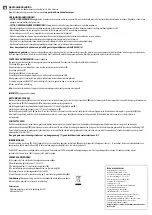
Arc Detection
The primary method to prevent arcing is to keep
all grounded objects at least 8 in. (20.3 cm) away
from the applicator. In addition, the Pro Xpc Auto
Controller is equipped with a feature called arc
detection. When the conditions suitable to create
an arc have been detected, the arc detection
circuitry disables the power supply drive circuitry and
produces an arc detection error. The power supply
drive circuitry remains disabled until the error has
been confirmed by the user or the PLC.
The controller has two adjustable arc detection
parameters: Static and Dynamic:
• Static Arc Limit monitors the ratio between current
and voltage. This ratio is affected by the distance
from the applicator to a ground and by the resistivity
of the fluid. The system turns off the high voltage
if this ratio gets too low.
• Dynamic Arc Limit monitors the rate of change
of the ratio between current and voltage. If a
grounded object approaches the applicator at too
high a speed, the system turns off the high voltage.
Both parameters can be set by the user to be
more or less sensitive than the factory default. See
. Static detection is adjustable
on a scale from 0.1 – 50. Dynamic detection is
adjustable from 0.1 – 25. Both static and dynamic
detection are less sensitive as the value is increased.
Setting
Remarks
Static Arc Limit *
View or change on Run
Screen 2, Location A1
Range: 0.1–50 nS
Set the value lower to increase sensitivity and to turn off the electrostatics sooner
as a grounded object approaches the applicator. Set the value higher to decrease
sensitivity and to eliminate nuisance errors.
Dynamic Arc Limit *
View or change on Run
Screen 2, Location A2
Range: 0.1–25 nS/s
Set the value lower to increase sensitivity and to turn off the electrostatics sooner if
a grounded object is approaching the applicator at too high a speed. Set the value
higher to decrease sensitivity and to eliminate nuisance errors.
* Must be set for each Preset.
NOTE: Periodically check the function of the arc
detection feature. Under safe conditions, with
electrostatics turned on, approach the the gun
electrode with a grounded rod and verify that the
electrostatics turn off. Observe the display to verify
that an error code of H15, H16, H17, or H18 is
displayed.
Averaging Interval
The arc detection averaging interval is used for
calculating the dynamic arc limit. The lower the
averaging interval, the more sensitive the dynamic
arc limit becomes. Lowering this setting adds to the
sensitivity achieved by setting the dynamic arc limit
itself. The default averaging threshold is adequate
for most applications.
BlankingTime
When electrostatics are turned on, or the set
points are changed during operation, the monitored
parameter may temporarily exceed the threshold
values of the arc detector. To avoid shutdown, arc
detection must be suppressed for a span of time
called the blanking time.
The Pro Xpc Auto Controller uses a fixed blanking
time, which is defined by the compensation factor
(C1) on Setup Screen 9. When the electrostatics are
enabled or changed, arc detection is suppressed for
the duration of the blanking time. The duration of the
turn-on transient depends on the voltage and current
set points, and the load resistance; so the blanking
time may need to be adjusted for the installation.
Blanking time has been factory set at 0.5 seconds.
Arc detection is deactivated during the blanking time.
333266D
43
















































